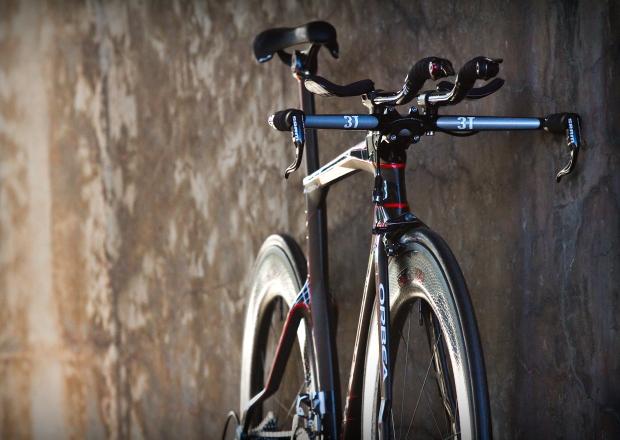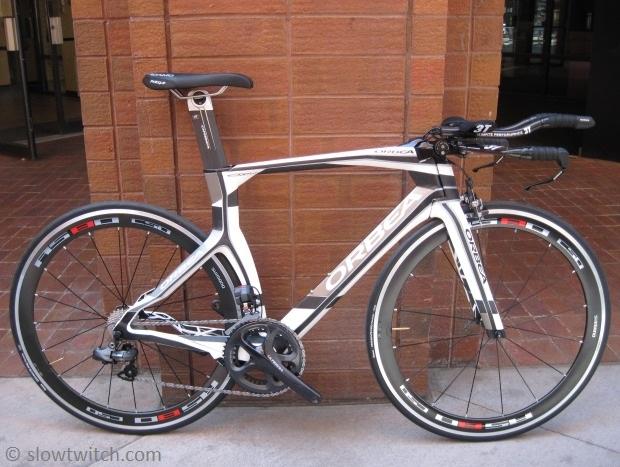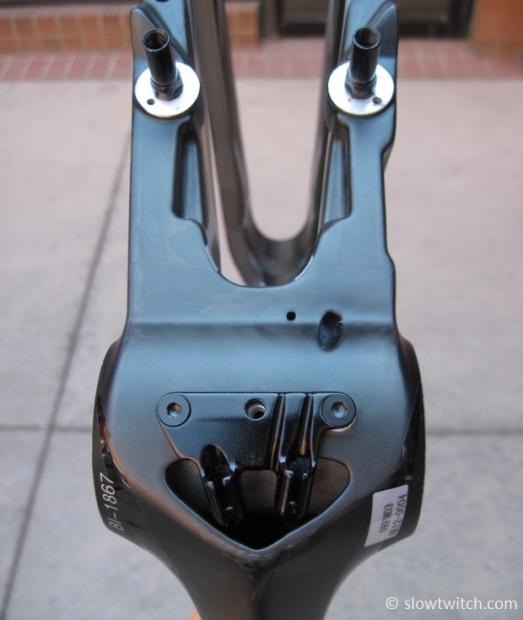2013 Orbea Ordu

Here it is – the much anticipated, brand-new Orbea Ordu. This was the “vaporware” bike of much controversy about one year ago, as Orbea’s key sponsored athlete appeared to be in a tough spot: Do I wait for this new bike for my upcoming two World Championship races, or do I kindly bow out and find another bike to ride? Certainly the previous model Ordu hadn’t held him back from some fantastic performances. However, he was also successful in the route he ultimately chose, which was winning both World Championships on two different brand bikes. And as it relates to Orbea, I’m firmly of the belief that there’s no such thing as bad press. It got people talking. It got people anticipating. Anticipating what?
This pretty little number:

Yes, the brand new Orbea Ordu. I had the opportunity to take a quick look at the new frame and complete bike as part of the USA Pro Cycling Challenge, in Denver, CO. Orbea chose a different route than the typical Eurobike-Interbike show launches. For one, this was much less expensive. And the added bonus is that press reports such as this one come out well before the flurry of activity from the big shows. Their message isn’t getting lost among the masses.
What is that message? After spending a morning with the bike and several folks from Orbea, I boil it down to this: a wider and smarter fit range, better parts specification, and clearly improved aerodynamics over the old version. What about downsides? The only tangible thing I could identify really came as no surprise – an increase in mechanical complexity. However, that is certainly not unique to Orbea, and they do not appear to be throwing any extra wrenches in the works than you’d expect in a modern high-end triathlon bike.
Fit
The best thing that Orbea has done to improve this bike – even beyond aerodynamics – is fit. While they retain a total of four frame sizes, the number of people that will fit this bike increased significantly. Here is a look at the stack and reach comparison of the 2012 and 2013 bikes:

The two sizes in the middle didn’t change all that much, nor did they really need to. The ends of the spectrum needed to be addressed. The largest bike got longer and taller – both much needed. You had guys like Orbea-sponsored Andrew Starykowicz squeezing on to the old large-size frame with a long stem – and flipping that stem upwards because of the too-short head tube. He made it work (and clearly still rode fast), but it was obviously not an ideal setup.
The smallest size frame is the real beauty. While it did get slightly longer, it also got much shorter due to a change from 700c to 650c wheels. Bike fitters can rejoice, and wives who want to borrow their husband’s race wheels can lament it (or – use this as an excuse to buy your own race wheels). However you look at it, the undeniable part is that - in terms of fit and low-speed-cornering safety - the move to a 650c wheel is a huge step forward for Orbea.
The other big change in fit is the front end of the bike. It has an integrated fork system. As a previous owner of a 2010 Felt DA, this looked eerily reminiscent.
Each frame or complete bike includes four stems: 75, 90, 100, and 110mm. Keep in mind, however, that the sizing is indeed done a little differently than my old Felt (and perhaps differently than other frames with highly integrated stems and forks). The now-standard measurements of stack and reach are static. They are what they are. The folks from Orbea were very clear that they understood stack and reach, and that they understood where the key ending coordinate lies – at the center and top of the headset. This was good news. The thing I wanted to know was – where does the stem length start and end?
This photo of my old bike illustrates the confusion. The red dot is your ending coordinate for stack and reach. Orbea agrees with this and measures to the exact same point on their frame.

What I wanted was the stem length. Is it the blue segment on the right? What about the green segment on the left? Felt did the sizing so it only included the blue portion on the right. A stem that was labeled 80mm was truly that – the little stem piece was exactly 80. The problem I ran in to with my Felt was the green segment… it seemed to get ignored. And - it added approximately four centimeters to the effective top tube length. Four centimeters that were not on the geometry chart. For those not privy to bike fitting, that’s not a distance you can just brush off as inconsequential. If you swap between a standard fork and the integrated fork, that changes the top tube length by roughly two bike sizes. That doesn’t make it a bad bike; it just means that you need a retailer who understands that those bikes fit really, really long when using the integrated fork.
After talking this through with the Orbea staff, I was reassured to learn that they understand the problem and do take it in to account. The stem length on these Orbea bikes is the blue plus the green – it all adds up to affect your resulting reach to the handlebars.
The stem adjusts on a single pivot to go up:

…or down:

In my experience, stems like this tend to make an easy fit for the middle 80 percent of the bell curve. Those of “average” fit. However, you do tend to get limited if you need the bars really high or really low. If you have really long legs and a high saddle, you will generally need the bars to come up higher. Likewise with short legs and lower bars. This is an issue that can be addressed by aerobar choice, however, so it tends not to be a deal-breaker for the frame itself. Those who need high bars can swap to a pylon-style stacking bar, such as the Bontrager Race X Lite or Zipp Vuka Alumina Clip. Those who need to get much lower could use, say, the 3T Mistral.
Orbea also addressed a much needed area of fit, simply by steepening the seat tube angle. The old bike was designed as a UCI-and-Tri bike, at 76 degrees. The new bike comes stock with a single seatpost which can adjust between 76 and 80 degrees of effective seat tube angle. Bravo, Orbea!
The seatpost is also unique in that it accepts two different saddle standards: the typical dual rail saddle, and Selle Italia’s new Monolink system.
The round hole accepts a mount for standard rails, and the channel in the middle is for Monolink style saddles.

Aerodynamics
This is what everyone wants to know about, right? How much faster is this thing? Orbea tells me that their primary testing site for the new frame was the A2 wind tunnel in North Carolina.

The new frame has its own unique shapes; nobody was referencing a copy of airplane wings or NACA profiles. I found it interesting that they are spec’cing the bike with a UCI-illegal fork; it has a 4:1 aspect ratio (meaning the depth of the fork legs are four times the width). Clearly, they are aiming this bike square at the triathlon market. They will offer a 3:1 fork option for those who race UCI events, such as their ProTour sponsored teams.
As for the aerodynamic performance of the frame, this is one area where we’ll just have to take their word for it – at least for now. Orbea quoted me with the following numbers:
“The new Ordu can save you up to 30 watts over the older bike at 10 degrees of yaw. Over the course of a 40km time trial, ridden at 25mph, this increase in efficiency could result in a roughly two minute time savings! With the same data, we calculate that the new Ordu could potentially shave roughly nine minutes from a 112 mile triathlon bike leg. Of course, efficiency may vary depending rider position and conditions.”
While I can’t verify their numbers personally, I will say that at first glance, the frame appears to have many design cues similar to other frames that show fast testing numbers.
Parts Specification
This Orbea is one of the first bikes to get Shimano’s brand new Ultegra Di2 TT.

This means you end up with phenomenal shifting performance, very low maintenance, and a price point that is attainable for many. The only downside? No brake lever shifting:

Wayne Stetina from Shimano was present at the launch, and he did give me a bit of secret information – you will be able to upgrade to brake lever shifting after the new 11-speed Dura Ace Di2 debuts in early 2013. Even though this Ultegra is still 10-speed, the new 11-speed brake lever shifters can be easily programmed to speak in 10-speed language.
Orbea does bikes in a similar way to, say, Trek. There is one frame and many different parts specifications. This is in contast to, say, Cervelo, who offer several levels of frame, each with fewer options in parts. I don’t think one is necessarily a better way to do it, but it is worth mentioning.
The big change for Orbea in parts spec can be seen either as a bright shining star, or a sore thumb. I’m guessing, however, that the vast majority of consumers and bike shops will see it as the former. What is it? ISM saddles come on these bikes from the factory.

Tony Karklins at Orbea simply said that they had to. The demand was so high that they had no choice. It got to the point where dealers were trying to order every bike without any saddle at all, because they knew they would inevitably swap out eighty percent of them for ISM. They chose the model which I think is likely most appropriate for the masses – the new Prologue. It is the same shape as the Podium and Breakaway, just with more padding. From firmest to softest, it goes Podium, Breakaway, and finally the plush Prologue.
The Mechanical Side of Things
As I previously eluded to, this new frame does have some increased mechanical complexity over its predecessor. For starters, the stem and steerer system is more complex than a standard stem. The preload still gets adjusted via a top cap, albeit somewhat hidden:

Once the preload is set, you turn the handlebars to the right to expose two 5mm bolts, which hold the adjustment.
Cables end up running over the top of the whole assembly:

Given how the cables run, I would advise anyone who is not using electronic shifting to use a sealed cable system, such as Gore Ride-On. Your sweat is going to drip right off your nose and on to this area of the bike… a non-sealed cable system would result in quickly degrading shift quality.
Next up is the bottom bracket. Orbea has chosen to go with PressFit BB86.

This means that it works with cranks that have a 24mm steel spindle, such as Shimano, SRAM, and FSA standard cranks. It also means that you cannot use a BB30 crank, unless you use the Rotor BB86 to BB30 conversion bottom bracket (it is the only option I’m aware of as of this writing).
The last key point to address in terms of mechanical function is the brake system. The front fork uses a standard caliper brake. However, the rear uses a Tektro mini-V style brake. This is a photo with the cover removed:

And here you see the cover being placed over it. It reminds me of the Trek Speed Concept:

With no brake installed at all, you can see that the system mounts to what appear like fairly standard cantilever post mounts.

My usual beef with brakes like this is simply that they tend to not have a great feel. As well, if you have a mid-race problem, such as a broken spoke (and wobbly wheel), you cannot simply open up the brake like on a normal caliper (via the cam lever). In terms of feel, I’d actually put this brake in the category of “good, but not great” (which is actually about as good as it gets for this style of brake). The Shimano brake levers help; I think they have the best feel of any TT lever I’ve tried. The best way to ensure good performance is to use a sealed cable system such as Gore Ride-On, and replace it when the brake starts to feel sluggish.
Miscellaneous Bits and Pieces
There is a single frame offered for both mechanical and electronic shifting. Note the front derailleur area. The small hole on the left is for a derailleur cable, and the larger hold on the right is for electronic:

The frame uses Orbea’s shock dampening system, called Attraction. Rather than using any sort of gel-like insert (such as Specialized Zertz), Orbea uses complex tube shaping and lower modulus carbon in key areas, such as the chainstays, seatstays, and fork.
Here is a view of the rear of the bike:

The last detail which I was curious about is indeed a big one. What about hydration? Many of our readers are dedicated long-course athletes, and this topic always comes up. Some folks prefer traditional bottles on the frame. Some like rear-mounted systems or aerobar-mounted systems. Then there are bladder systems, such as the new Shiv’s internal system. My eye spied that the new Ordu featured a single frame bottle mount. Seeing as most of us don’t want to race long course with a single bottle, this means you must use some sort of alternative mounting system. You can go between the aerobars, but also keep in mind that due to the bike’s cable routing on top of the stem, your real estate for Garmins, bento boxes, and the like, is limited.
In speaking with the Orbea staff, there seemed to be about an even 50/50 split on opinion of the subject of a single bottle mount. But – it was also made known that the frame is not 100% absolutely final, so this could change. If you want to see two frame bottle mounts, now is the time to vote and let your dealer know how you feel.
Overall, I think Orbea has made some good strides in the right direction with this bike. I look forward to spending more time with one for some real test riding, but hopefully this quick look satisfies your desires in the meantime. If this bike is up your alley in terms of fit, I think it deserves a place on the list among other modern “super bikes”.



